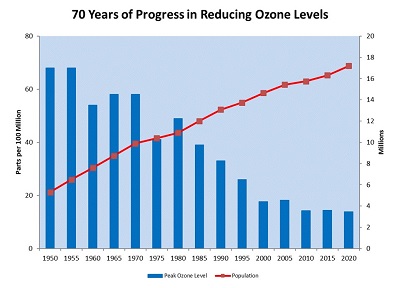Mission
To clean the air and protect the health of all residents in the South Coast Air District through practical and innovative strategies.
(Return to Top)
What is the South Coast AQMD?
The South Coast AQMD is the air pollution control agency for all of Orange County and the urban portions of Los Angeles, Riverside and San Bernardino counties. This area of 10,743 square miles is home to over 16.8 million people–about half the population of the whole state of California. It is the second most populated urban area in the United States and one of the smoggiest.
Different types and levels of air pollution can cause or contribute to everything from watery eyes and fatigue to respiratory disease, lung damage, cancer, birth defects and premature death. Because this area’s smog problem is so severe, South Coast AQMD often finds itself at the forefront of the nation’s emission reduction efforts.
(Return to Top)
What South Coast AQMD Does

South Coast AQMD is responsible for controlling emissions primarily from stationary sources of air pollution. These can include anything from large power plants and refineries to the corner gas station. There are about 28,400 such businesses operating under South Coast AQMD permits. Many consumer products are also considered stationary sources; these include house paint, furniture varnish, and thousands of products containing solvents that evaporate into the air. About 25% of this area's ozone-forming air pollution comes from stationary sources, both businesses and residences. The other 75% comes from mobile sources–mainly cars, trucks and buses, but also construction equipment, ships, trains and airplanes. Emission standards for mobile sources are established by state or federal agencies, such as the California Air Resources Board and the U.S. Environmental Protection Agency, rather than by local agencies such as the South Coast AQMD.
(Return to Top)
How South Coast AQMD Controls Pollution

South Coast AQMD develops and adopts an Air Quality Management Plan, which serves as the blueprint to bring this area into compliance with federal and state clean air standards. Rules are adopted to reduce emissions from various sources, including specific types of equipment, industrial processes, paints and solvents, even consumer products. Permits are issued to many businesses and industries to ensure compliance with air quality rules. South Coast AQMD staff conducts periodic inspections to ensure compliance with these requirements. The test of whether these efforts are working is the quality of the air we breathe. South Coast AQMD continuously monitors air quality at 38 locations throughout the four-county area. This also allows South Coast AQMD to notify the public whenever air quality is unhealthful.
The test of whether these efforts are working is the quality of the air we breathe. South Coast AQMD continuously monitors air quality at 38 locations throughout the four-county area. This also allows South Coast AQMD to notify the public whenever air quality is unhealthful.
(Return to Top)
South Coast AQMD’s Sources of Revenue
To meet its financial need, the South Coast AQMD utilizes a system of evaluation fees, annual operating fees, emission fees, Hearing Board fees, penalties/ settlements and investments that generate approximately 73% of South Coast AQMD’s revenue. The remaining 27% of its revenue is from federal grants, California Air Resources (CARB) subvention funds, and California Clean Air Act Motor Vehicle fees.
(Return to Top)
Progress So Far
Air quality in this area has continually improved despite an enormous increase in population and cars. For example, maximum levels of ozone, one of our worst smog problems, have been cut to less than one quarter of what they were in the 1950s, even though today we have nearly three times as many people and four times as many vehicles.
In the past decade, we have eliminated Stage I smog alerts, which used to occur 100-120 times a year. We have not reached Stage II levels, since the 1980s.
(Return to Top)
The Job Ahead
The clean air effort still has a long way to go. In 2005, the federal 1-hour standard was replaced by a stricter 8-hours standard that was further strengthened in 2008. Even though recent years have been the cleanest on record, our air in the South Coast Air Basin still exceeded the federal health 8-hour standard for ozone on 113 days in 2009. Maximum levels are almost twice as high as the federal standard for clean air.
State and federal law requires this area to meet existing clean air standards by the year 2015 for annual PM 2.5; and by 2023 for the 8-hour average ozone standard. However, tougher federal air quality standards for particulates and ozone issued in 2006 and 2008 will require reductions above and beyond those already planned. South Coast AQMD estimates it will take until at least 2020 to meet the new 24-hour average particulate standard, and until 2030 to meet the new ozone standard. This may seem like a long time to continue to live with smog. But the cleanup effort is enormous. Even though we already have the strictest pollution control requirements in the nation, we still have to reduce some types of pollution by up to 90% if we are to rid the area of smog.
The war on smog began in this region more than a half century ago. With continued commitment and sensitivity to the impacts of efforts to control smog, residents can be assured that public health standards for air quality will be achieved.
(Return to Top)
How You Can Help
A lot of our pollution comes from the products and services we use every day. We can all help by making some simple changes in the way we live: carpool, use public transit, use water-based paint, wet down sources of dust, avoid aerosol products, recycle, and conserve energy.
For additional information, call 1-800-CUT SMOG® to order South Coast AQMD’s free publications; or you can view and download them from here, “Newsletters, Brochures, & Fact Sheets.”